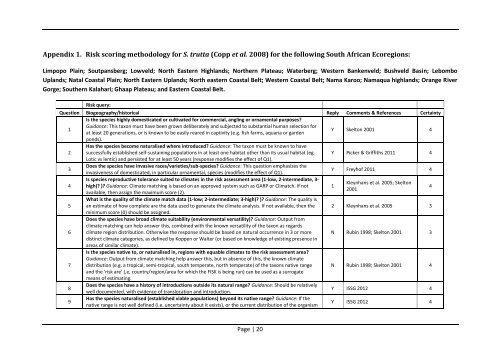Brown trout Salmo trutta - Department of Agriculture, Forestry and ...
Brown trout Salmo trutta - Department of Agriculture, Forestry and ...
Brown trout Salmo trutta - Department of Agriculture, Forestry and ...
You also want an ePaper? Increase the reach of your titles
YUMPU automatically turns print PDFs into web optimized ePapers that Google loves.
Appendix 1. Risk scoring methodology for S. <strong>trutta</strong> (Copp et al. 2008) for the following South African Ecoregions:Limpopo Plain; Soutpansberg; Lowveld; North Eastern Highl<strong>and</strong>s; Northern Plateau; Waterberg; Western Bankenveld; Bushveld Basin; LebomboUpl<strong>and</strong>s; Natal Coastal Plain; North Eastern Upl<strong>and</strong>s; North eastern Coastal Belt; Western Coastal Belt; Nama Karoo; Namaqua highl<strong>and</strong>s; Orange RiverGorge; Southern Kalahari; Ghaap Plateau; <strong>and</strong> Eastern Coastal Belt.Risk query:Question Biogeography/historical Reply Comments & References Certainty1Is the species highly domesticated or cultivated for commercial, angling or ornamental purposes?Guidance: This taxon must have been grown deliberately <strong>and</strong> subjected to substantial human selection forat least 20 generations, or is known to be easily reared in captivity (e.g. fish farms, aquaria or gardenY Skelton 2001 4ponds).2Has the species become naturalised where introduced? Guidance: The taxon must be known to havesuccessfully established self-sustaining populations in at least one habitat other than its usual habitat (eg. Y Picker & Griffiths 2011 4Lotic vs lentic) <strong>and</strong> persisted for at least 50 years (response modifies the effect <strong>of</strong> Q1).3Does the species have invasive races/varieties/sub-species? Guidance: This question emphasizes theinvasiveness <strong>of</strong> domesticated, in particular ornamental, species (modifies the effect <strong>of</strong> Q1).Y Freyh<strong>of</strong> 2011 44Is species reproductive tolerance suited to climates in the risk assessment area (1-low, 2-intermediate, 3-Kleynhans et al. 2005; Skeltonhigh)? )? Guidance: Climate matching is based on an approved system such as GARP or Climatch. If not 12001available, then assign the maximum score (2).4What is the quality <strong>of</strong> the climate match data (1-low; 2-intermediate; 3-high)? )? Guidance: The quality is5 an estimate <strong>of</strong> how complete are the data used to generate the climate analysis. If not available, then the 2 Kleynhans et al. 2005 3minimum score (0) should be assigned.6Does the species have broad climate suitability (environmental versatility)? Guidance: Output fromclimate matching can help answer this, combined with the known versatility <strong>of</strong> the taxon as regardsclimate region distribution. Otherwise the response should be based on natural occurrence in 3 or more N Rubin 1998; Skelton 2001 3distinct climate categories, as defined by Koppen or Walter (or based on knowledge <strong>of</strong> existing presence inareas <strong>of</strong> similar climate).7Is the species native to, or naturalised in, regions with equable climates to the risk assessment area?Guidance: Output from climate matching help answer this, but in absence <strong>of</strong> this, the known climatedistribution (e.g. a tropical, semi-tropical, south temperate, north temperate) <strong>of</strong> the taxons native range N Rubin 1998; Skelton 2001 4<strong>and</strong> the ‘risk are’ (,e, country/region/area for which the FISK is being run) can be used as a surrogatemeans <strong>of</strong> estimating.8Does the species have a history <strong>of</strong> introductions outside its natural range? Guidance: Should be relativelywell documented, with evidence <strong>of</strong> translocation <strong>and</strong> introduction.Y ISSG 2012 49Has the species naturalised (established viable populations) beyond its native range? Guidance: If thenative range is not well defined (i.e. uncertainty about it exists), or the current distribution <strong>of</strong> the organismY ISSG 2012 4Page | 20
















